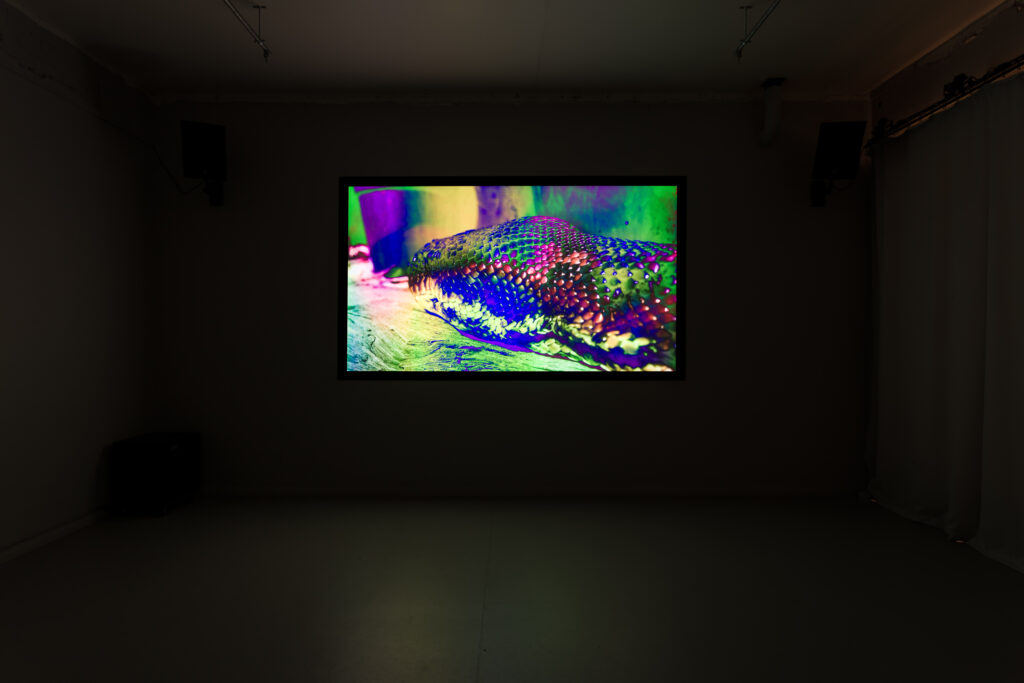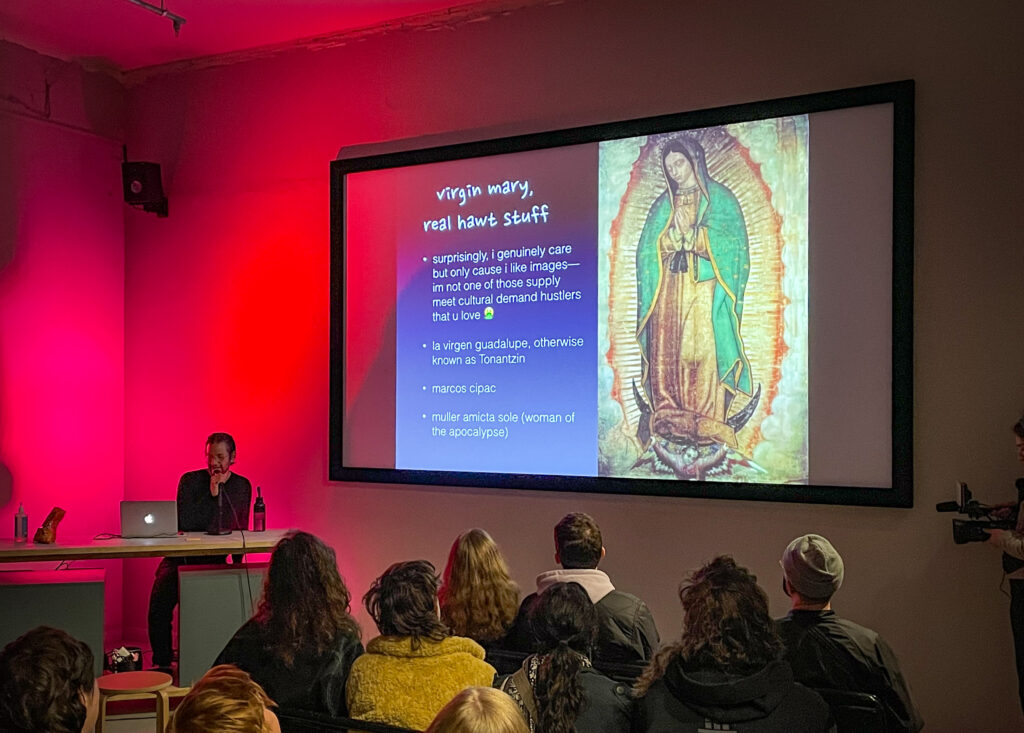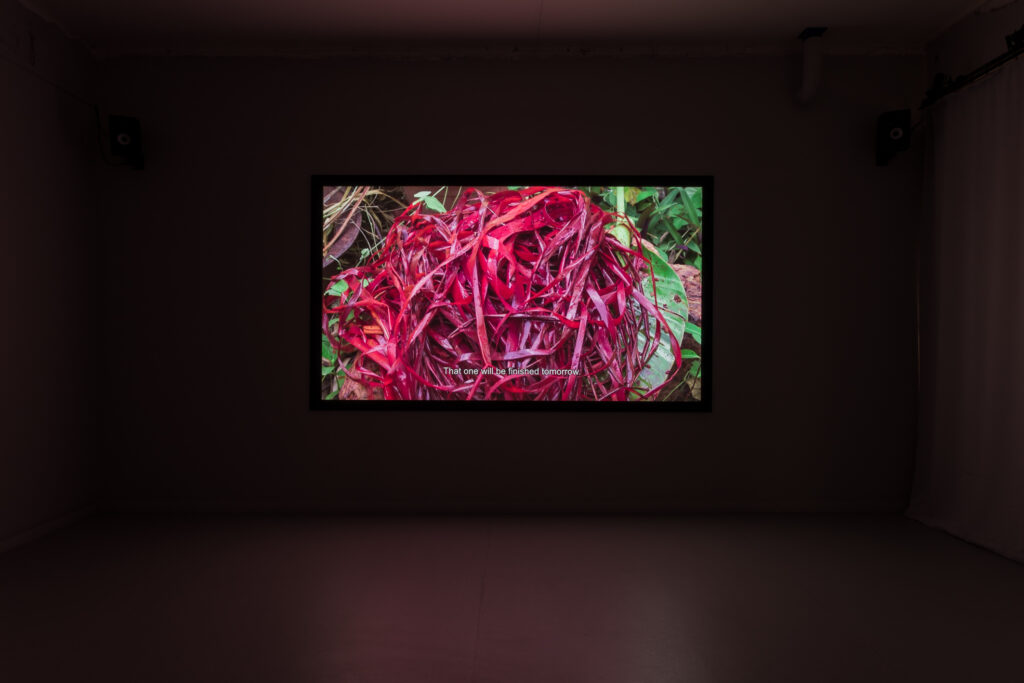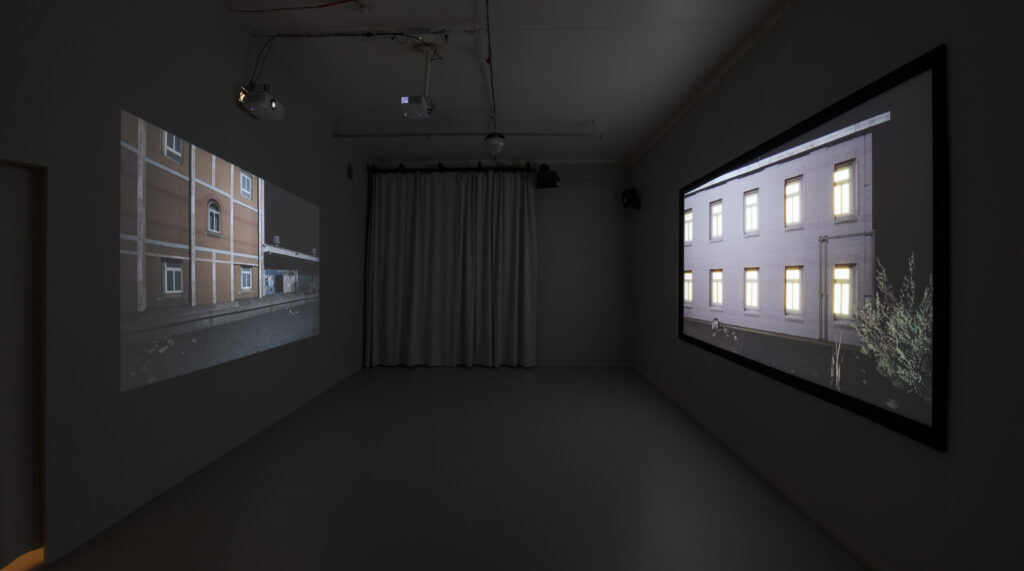Be it the embodied performances of Jill Orr and Mike Parr, VNS Matrix’s seminal cyberfeminist interventions, or Lou Hubbard’s ongoing exercises in formal deconstruction, it often goes understated just how crucial an ingredient the moving image has been in the constitution of Australian art history in the past fifty years. Looking towards the future, and now more so than ever, the moving image claims dominance within the institutional art circuit, having overtaken the still photographic image as the preeminent visual language of the times. Just as the screen has become the site wherein we enact our social and working lives, its pervasive and seductive offerings proves to be fertile soil for cultural critique, inviting an artistic response to an era defined by an attention-deficit society collectively attuned to the rhythm of video’s restless pace.
Celebrating its first birthday, Composite is Naarm’s local art stalwart Channon Goodwin’s answer to a growing need for a dedicated outpost to emerging forms of moving image practice whilst consolidating the rich and highly varied heritage of video art within the Australian context. As the name suggests, Composite is an organisation designed to support contemporary moving image practice and its communities, engaging in a constellation of activities as diverse and layered as the work that it shows. Karl Halliday, a lens-based artist and curator, spoke with Channon to learn more.

Karl Halliday: “Hello Channon, love to see you. Thanks for taking the time to chat. Perhaps you could begin by introducing Composite?”
Channon Goodwin: “Sure. Composite is a new artist-run organisation that supports artists’ working with the moving image. It does so through curated and open-call programming at our screening space located at Collingwood Yards and by providing development support through our media bank of audiovisual equipment and funding for the production and exhibition of new work. Overall, Composite seeks to foster local film and video practice by providing a specific context that is designed to display, discuss, and celebrate such work.”
KH: “You and I met in 2018 shortly after I migrated to Naarm when I started volunteering at Bus Projects, where you served as Director. I remember wondering what would be next when you stepped down from the role in 2021, always having admired the incredible work you did over the years in cultivating Bus into a pioneering example of a self-organised operation of international reach, demonstrating the meaningful impact ARIs have and are capable of. Fortunately, it was not long before Composite was established following your departure. I’m curious, what was the path that led you to this new chapter, forming Composite?”
CG: “Thank you. Well, Composite is an idea that evolved out of research I had undertaken in 2019 and 2020 during an Australian Council for the Arts International Residency at ACME Studios in London, where I examined the lineage of artists’ video and filmmaking collectives. I wanted to understand how those collectives had evolved into formal organisations and institutions, and why this happened, looking at its impact on practice and thinking about what it would mean in an Australian context to create an organisation dedicated to moving image practice.
This residency led to conversations with established organisations such as LUX Scotland which supports, develops and promots artists’ moving image practices for its local context in Scotland. LUX Scotland is an offshoot of LUX in London which, in turn, emerged from predecessor organisations: the London Filmmaker Co-operative, London Video Arts and the Lux Centre. Another important encounter in the development of Composite was visiting Pavilion in Leeds and attending their Artists’ Moving Image Network meeting which provided an exciting example of how to foster communities around moving image practice.
In comparison to the long-running organisation encountered on my travels, Composite is a relatively small and straightforward venue with a simple cinema-style set-up, essentially a single large fixed screen and sound system. Its compact but concentrated scale allows Composite to be a friendly environment that supports conversation and gathering, making it a welcoming space for sharing and discussing work. This is an important strand of activity that I hope Composite continues to develop, becoming known not only as a presentation space, but also as community space and for recording, education, and skill sharing. It reflects my ambition of creating somewhere that is considered an important convergence point for Australian moving image practice. This is reinforced by my long-standing belief in the import role of Australia’s vital network of small-scale artist-run organisations.”

KH: “You have been heavily involved with Naarm’s art scene for some fifteen years. Would you say Composite is a response to your experience of a perceived lack in Naarm’s current landscape for organisations supporting moving image practice?”
CG: “My aim to create a supportive platform for artists’ working with moving image comes from my own experience as an artist. Studying and working as an artist and artsworker in Meanjin/Brisbane in the early 2000s I benefited from a range of support structures provided by other artists and organisations. A notable example during this time being MAAP - Media Art Asia Pacific and their Media Bank. MAAP was founded by Kim Machan in 1998, and continues to produced exhibitions with a focus on digital and electronic art forms such as video installation, online art, interactive multimedia. My peers and I were often able to put on some quite ambitious exhibitions of multi-screen and multi-channel projection video and sound work because we could source expensive equipment from the MAAP Media Bank.
Even before I arrived in Narrm/Melbourne, I was aware of the exciting video and sound work being presented in spaces such as KINGS, Bus Projects, and Blindside. By the time I moved down in 2012, I was excited by new initiatives like Screen Space (2010-2016) co-directed by founders Simone Hine, an artist, and Kyle Weise, a writer. Screen Space was a not-for-profit independent gallery dedicated to the exhibition of art that uses screen-based technology or incorporates the projected or moving image, or work in any media that engages directly with screen culture. Similar to my aims with Composite, Screen Space developed programming and its architectural space in order to meet this specific curatorial goal.
My arrival in Narrm/Melbourne also coincided with the launch of Channels Festival, an artist-run festival dedicated to showcasing emerging trends in contemporary video art practice from around the world. With the closure of Screen Space in 2016, Composite was first conceived as a entity that could provide continuity of support to artists between Channels’ festival activity.
Above all, Composite is my attempt to create a useful site, encouraging artists to create moving image work in a single channel format and, looking to the future, distribute that work. In short, being a space that encourages the showing, contextualising, making of moving image work, and one that creates an economic flow for that work globally.”

KH: “I do find it intriguing that Composite sticks to the single screen, and not just as a point of difference to the big-scale and even bigger budget, multi-screen spectacles à la Richard Mosse that seem to now dominate the institutions. Because when considering the history of the development of video art and the moving image in a gallery context, it was an emergence always in contention with cinema. Or at least, the idea that, instead of a sedentary audience, you have an itinerant spectator, and this meant space became a constituent ingredient in the experience, and critique, of video installation work. Here I am reminded of Michael Snow’s Two Sides to Every Story (1974), or Anthony McCall’s Line Describing a Cone (1973) the whole schtick of ‘Expanded Cinema’, or even ‘multi-media’ performance art practices involving projection in the vein of Nam June Paik and Carolee Schneemann - works that incorporated the gallery space as an instrument with the intent of emancipating the moving image from the cinematic model of spectatorship by distinguishing it on the level of audience experience. The now-typical gallery-friendly system of looping a film or splintering the image across multiple spaces were structural devices designed to decenter traditional models of spectatorship, whereby having both a moving image and a moving audience untied to any one strict length of time resisted the notion of fixed comprehensive ‘point of view’ or an authorial position could be asserted - a situation of what Boris Groys called ‘invisibility’. Yet Composite is different in that it goes against the tide to mimic the model of the cinema theatre, with an events-based program much like a cinema where audiences gather at a specific time and suspend their attention for a duration determined by the video maker, instead of exercising their own liberty as you’d find in a gallery.”
CG: “Totally, and there are challenges in the sense that most current practice is being made with the need for an installation-based model of presentation in mind, or forms with spatial elements, et cetera. Returning to your question about whether Composite responds to a lack, this for me reaffirms Composite’s existence as a compliment to those existing platforms that focus on spatially engaged moving image practices. In that way, Composite provides a useful annex to that activity, by offering a space for works that suit it, especially in instances where having an event-based model as part of the deployment. As such, I hope that Composite fits neatly within the offerings available to other artists in other galleries and organisations without forcing itself onto the scene, promoting a healthy ecology. I learnt alot from conversations with the folk at Circuit Artist Moving Image Aotearoa/New Zealand, an arts agency that supports New Zealand artists working in the moving image about how to respond to the nature of local practice. Understanding how your organisation is useful to artists is really important.”

KH: “In thinking about terminology with the history of grassroots “collectives” such as the Jonas Mekas’ Filmmaker’s “Co-op”, and the equivalent London Filmmaker’s Co-op that later went on to form LUX, the name ‘Composite’ itself continues this heritage, in emphasis of the many relationships that comprise it. You have described Composite as ‘a body with many parts’ - namely as a screen space, a production space, as well as the various areas of focus in Composite’s operation, including dissemination, licensing, and advocacy of moving image practice, and the archival aspect of having an open access media library that artists can freely contribute to. The name Composite also seems to relate to the collaborative nature of co-programming events with other organisations, and the benefit of shared resources, a coming together of heads and hands which is arguably as much a celebration of collectivity as it is a testament to the precarity of moving image practice which is still seen as a fringe practice in an already unstable, under-funded and over-worked industry.”
CG: “Speaking about Composite as having many parts also relates to my desire to accommodate a diversity of practice from a programming core that focuses on artists film and video and expanding outwards to engage with performance, sound art, music, dance, internet radio and aspects of filmmaking. While it might not be so common for artists in Australia to make feature length video work in a cinematic single-channel mode, the intention with Composite is to foreground the moving image and invite audiences to enjoy the site in that way.
The space itself offers an exhibition program all year, as well as a rolling series of events, partnerships, performances, and recordings; and having our venue situated at a multi-artform complex like Collingwood Yards allows us to operate as a convergence point for different artistic communities. Just last night we had a live music broadcast from our resident radio station Crawl Space Radio...”
KH: “Such a sick name!”
CG: “Haha, yeah it is. We also just held the latest iteration of our partnership with SEVENTH Gallery, Release Cycle featuring Ari Tampubolon, which is a series where an artist is invited to select work from their back catalogue alongside current work and present it in a format of their choosing. Sometimes it is a presentation with a theatrical element, other times it is a long playlist of work presented over two hours in the evening. In this way, Composite’s program is a blend of format and presentation, but it appears as a small theatrette or speakeasy-style cinema which is still strange enough in a visual art context to be interesting. We invite audiences in for a defined period of time, the room goes dark, and the film comes on, and when it ends we applaud and go on to one of the bars on site for conversation and critique. And now that we have built up a track record over the past year, we are ready to throw open our doors as we prepare to launch our first open call in about a month. We have an exciting year ahead!”
Karl Halliday is a Naarm-based photographic artist, writer and curator, with a keen focus on lens-based practice, conceptually-driven forms of artmaking and the intersection of photography and publishing. An impassioned advocate for the cultural, educational and therapeutic value of the arts, Karl is dedicated to creating opportunities for artists to share their ideas, develop their practices and connect with new audiences. Since 2020, Karl has served as Chair of the Board of Directors at Blindside, and coordinates the Projects Space at Linden New Art. He holds a Masters in Art Curatorship from the University of Melbourne.
Channon Goodwin is an artist and artsworker whose work engages with collective, collaborative, and artist-run practice and forms of artist-led organisation building. Channon is the founding Director of Composite Moving Image Agency & Media Bank, and Convener of All Conference, an organising network comprised of 17 artist-led, experimental and cross-disciplinary arts organisations from around Australia. From 2012–2021, he was Director of Bus Projects, one of Narrm/Melbourne's longest-running Artist-Run Initiatives. He aggregates his various collaborative and independent videography work under Fellow Worker. In 2019, Channon was awarded an Australia Council for the Arts International Residency at ACME in London, where he examined the lineages of artists’ video and filmmaking cooperatives. He also edited Permanent Recession: a Handbook on Art, Labour and Circumstance (2019), published through Onomatopee Projects. This book is an enquiry into the capitals and currencies of experimental, radical and artist-run initiatives in Australia and the labour conditions of working artists. Channon is currently undertaking a PhD research project at RMIT that focuses on artists’ collective, participatory and activist activities, and the new forms of social, cultural and economic value they create, as well as the ways this activity improves the working and living conditions of visual artists in Australia.
un Projects’ Editor-in-Residence Program is supported by the City of Yarra.
